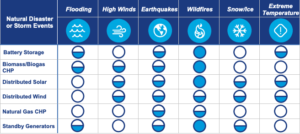
By Lynn A. Kirshbaum, Deputy Director of the Combined Heat and Power Alliance
This post is the first in a three-part series on the CHP Alliance’s Virtual Summit.
Earlier this month, the CHP Alliance hosted its 2020 Virtual Summit: The Role of CHP in a Low-Carbon Future. We had more than 240 attendees from industries and sectors including CHP development, design, manufacturing, engineering, distribution, and construction; federal, state, and municipal government; electric and gas utilities; non-profits; universities; trade associations finance and investment; and end-users. Attendees hailed from 31 states and the District of Columbia, as well as eight countries outside the U.S.
The goal of the Summit was to bring together experts from across the CHP industry and beyond to talk about CHP and how it can help to reduce emissions, improve electric reliability and community resiliency, and save money. Attendees heard from over 50 speakers over the course of three days during panels, keynote addresses, and breakout sessions. Our speakers included government officials, end users of CHP systems, those in the nonprofit sector, electric and gas utilities, energy industry analysts, and those from across the CHP industry, including engineering, development, and financing. The Summit provided a great opportunity to learn from each of our speakers and from each other.
On the first day of the Summit, we heard from the CHP Alliance’s Executive Director, David Gardiner. David outlined a vision and goals for CHP in 2030 and the tools needed to achieve these goals.

We polled those in attendance and were encouraged to hear that 78% thought our goal to increase new deployment by 25% by 2030 was “just right,” while another 18% thought that we could be even more ambitious.

This presentation also highlighted the benefits that could be achieved by increasing CHP deployment by 25%. The CHP Alliance calculated that this increased deployment would:
- Reduce annual CO2 emissions by 24,468,750 short tons
- Equivalent to 5.7 coal-fired power plants
- Save 137,891,250 MWh electricity annually
- Save businesses more than $70 billion (2011$) cumulatively
Our first keynote address was given by Senator Angus King (I-ME). In his remarks, Senator King noted that in order to slow down the process of climate change, we are going to have to do everything we can think of, particularly things that are cost-effective, and CHP is one of the most cost-effective things we can do. He also commented that a lot of smaller solutions will contribute to the solution of the bigger problem, and CHP is one of those solutions. Senator King also observed that a lot of people don’t know about CHP or understand how it works, noting that there is more education to be done about how CHP increases the efficiency of whatever fuel it uses. Educating people about CHP was a theme throughout the Summit, highlighting the need to ensure that more people understand CHP and the benefits that can be realized through additional deployment.
The first panel of the Summit provided an overview of the State of the Market for CHP. Various market drivers contribute to the continued deployment of CHP technologies, including reduced operating costs, environmental benefits, resiliency, and operational flexibility. The panelists noted several market trends, including a move towards smaller CHP installations in “non-traditional” CHP applications and packaged CHP systems, the value of resilience as a driver for CHP, CHP as an anchor for resilient microgrids, hybrid CHP systems, micro CHP systems, and a growing interest in CHP by utilities. This panel set the stage for themes that we would hear about throughout the Summit.
Better Buildings: U.S. Department of Energy. “Issue Brief: Distributed Energy Resources Disaster Matrix.“


Matrix of DER Vulnerability to Weather Events.
Our last panel of the day focused on innovative approaches to CHP Financing. CHP projects are frequently capital intensive, and financing can be a complex process as there are numerous options and factors to consider. Third-party financing was a focus of this panel as a financing option that is growing in popularity. Many potential CHP system hosts are medical facilities, universities, and hotels: their core business is not energy. This can pose challenges for financing CHP projects, as these projects may compete for internal capital dollars. Innovative financing solutions, such as third-party financing, can help to bridge this gap, allowing these types of facilities to successfully implement CHP projects. Echoing a theme from Senator King’s discussion, we also heard from this panel that educating the investment community about CHP benefits and risks could help to encourage more investors to become interested in CHP.
The first day of the Summit was a great start to the event! In addition to the plenary sessions, attendees also gathered in small groups to participate in 12 breakout sessions on a variety of CHP topics, and had opportunities to network with their fellow attendees. The next two days promised to deliver even more insights!
Check back here to see our wrap-up about day 2 and day 3 of the event! In addition, throughout the fall months, we will have a CHP Summit Insights series, where guest authors will share key takeaways from many of the Summit’s panels and keynote addresses.
Want to learn more about these topics? Read our previous blog posts on CHP and microgrids, and CHP as an alternative to new central gas plants, as well as our factsheet on how CHP and WHP can reduce emissions.
Want to stay updated about future CHP Alliance events? Click here to be added to our mailing list.
